Bear Course, Lily, Holly, Jewel – UPDATE July 2, 2014
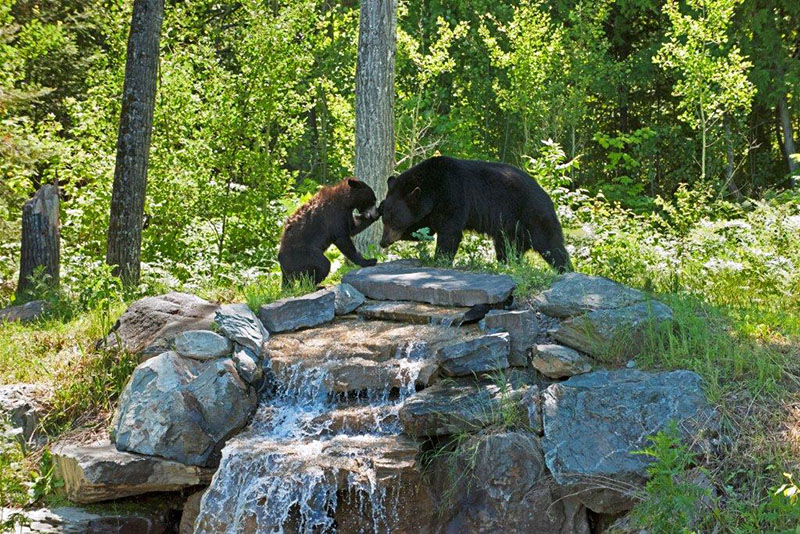 Holly and Lucky playing on fallsOur first Black Bear Field Course ended today with another visit to Lily. About 8:30 AM, a call came in that Lily was at a community feeding station, and the group quickly mobilized to see her one last time.
Holly and Lucky playing on fallsOur first Black Bear Field Course ended today with another visit to Lily. About 8:30 AM, a call came in that Lily was at a community feeding station, and the group quickly mobilized to see her one last time.
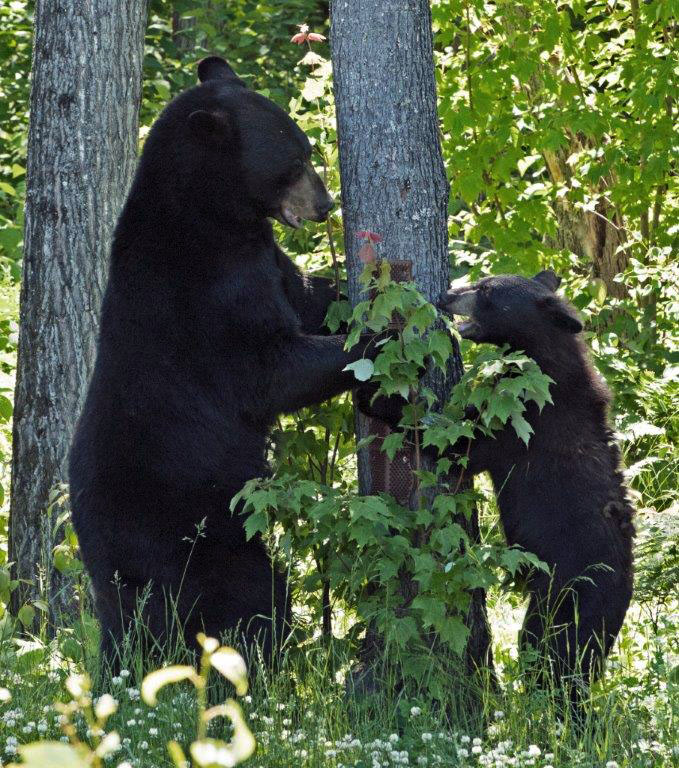 Holly and Lucky playingLater, we caravanned to the Bear Center to meet Ted and Lucky and watch the latest step in Holly’s integration into the social order. We were happy to see Ted walking fine in his new pen—and he was happy to see us. Holly is looking great as she sheds her old fur and sleek new fur is covering her ears, sides, face, and legs. Most of the old fur has shed from her back. Her ears stand up nicely now. We watched her confidently approach Lucky and lie down to eat a couple feet from him. We saw her stand up and initiate play, which has become a big part of both their lives. They played on top of the big waterfalls and they played around an aspen tree. Both had their play faces on with mouths open and their ears pointing out to the sides and a little back with the leading edge of the ear rotated down so the back of the ear is toward the sky.
Holly and Lucky playingLater, we caravanned to the Bear Center to meet Ted and Lucky and watch the latest step in Holly’s integration into the social order. We were happy to see Ted walking fine in his new pen—and he was happy to see us. Holly is looking great as she sheds her old fur and sleek new fur is covering her ears, sides, face, and legs. Most of the old fur has shed from her back. Her ears stand up nicely now. We watched her confidently approach Lucky and lie down to eat a couple feet from him. We saw her stand up and initiate play, which has become a big part of both their lives. They played on top of the big waterfalls and they played around an aspen tree. Both had their play faces on with mouths open and their ears pointing out to the sides and a little back with the leading edge of the ear rotated down so the back of the ear is toward the sky.
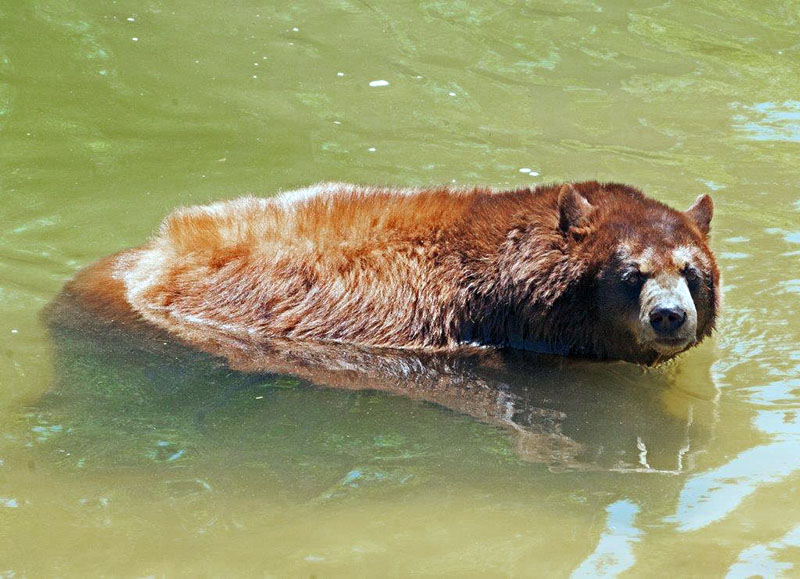 Honey in-pondThroughout the bear course, the wild bear viewing was great. We asked the one returnee in this group how this course compared with her previous course in 2012. She said, “There were many more bears with less effort. Without the radio-collars, we weren’t taking long rides and hikes following radio signals. Now, the bears come to us. We see more bears and more observations of interactions among bears packed into the day—plus the ability to interact with certain bears. This course is better suited for people who can’t walk such long distances.” Another participant remarked as we leisurely walked to one of Lily’s dens that she had “never seen such a beautiful forest except in National Geographic.” Along the way, she and others asked questions about the wildflowers, trees, and scat.
Honey in-pondThroughout the bear course, the wild bear viewing was great. We asked the one returnee in this group how this course compared with her previous course in 2012. She said, “There were many more bears with less effort. Without the radio-collars, we weren’t taking long rides and hikes following radio signals. Now, the bears come to us. We see more bears and more observations of interactions among bears packed into the day—plus the ability to interact with certain bears. This course is better suited for people who can’t walk such long distances.” Another participant remarked as we leisurely walked to one of Lily’s dens that she had “never seen such a beautiful forest except in National Geographic.” Along the way, she and others asked questions about the wildflowers, trees, and scat. 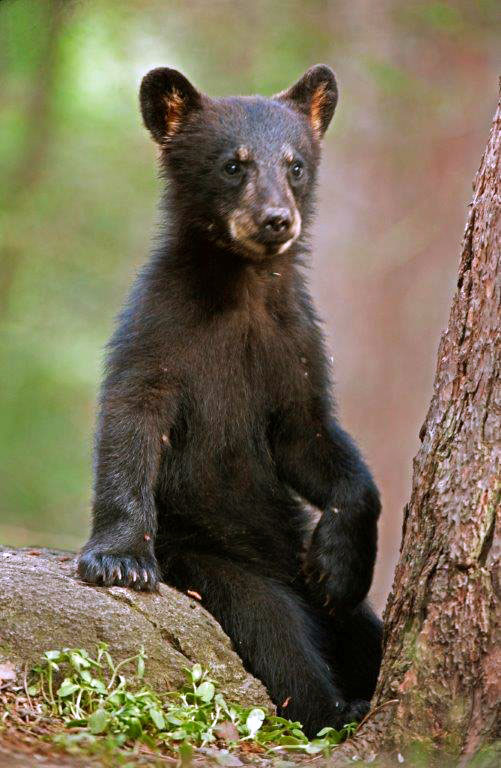 Jewel's cubAnother remarked how great it was to watch bears interact and get a sense of real bear life. A teacher who watched the lighted yard into the night remarked how an owl swooped in and caught a small mammal. By day, two participants photographed the pileated woodpecker hatchlings being fed and noted that they don’t cheep like a person might expect—they give full adult calls. (That means they could fledge and fly away any day now). Another participant particularly enjoyed the hours on the pontoon boat photographing wildlife as we edged toward the destination they called their mecca—Lily’s den where she gave birth to Hope. A highlight was finding that the first white pine Hope climbed, where she and Lily spent their first night away from the den, now holds the eagle nest where we photographed the eagles from the pontoon boat. The less strenuous day allowed participants to save energy for watching the stream of bears that showed up in late afternoon and continued after bedtime.
Jewel's cubAnother remarked how great it was to watch bears interact and get a sense of real bear life. A teacher who watched the lighted yard into the night remarked how an owl swooped in and caught a small mammal. By day, two participants photographed the pileated woodpecker hatchlings being fed and noted that they don’t cheep like a person might expect—they give full adult calls. (That means they could fledge and fly away any day now). Another participant particularly enjoyed the hours on the pontoon boat photographing wildlife as we edged toward the destination they called their mecca—Lily’s den where she gave birth to Hope. A highlight was finding that the first white pine Hope climbed, where she and Lily spent their first night away from the den, now holds the eagle nest where we photographed the eagles from the pontoon boat. The less strenuous day allowed participants to save energy for watching the stream of bears that showed up in late afternoon and continued after bedtime.
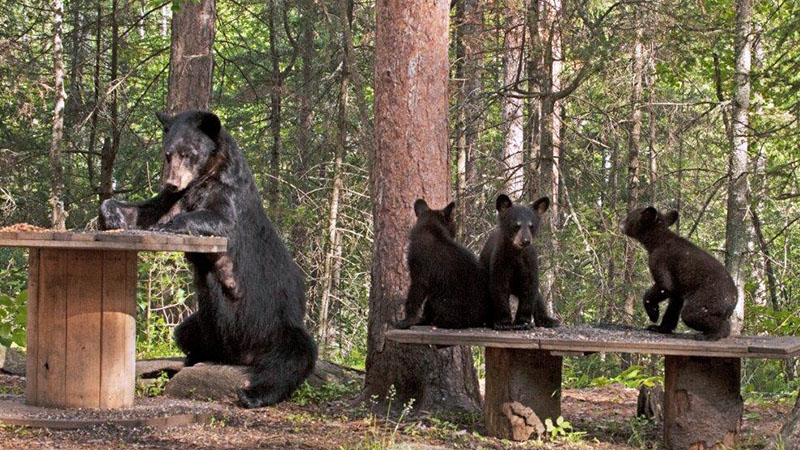 Jewel and cubsBelieve it or not, some insisted course highlights were Lynn’s informative slide-lectures and Sue’s field trip to teach bear sign. The teachers said the presentations gave them so much to take back to their students. Participants from bear country said they couldn’t wait to look for bear sign back home.
Jewel and cubsBelieve it or not, some insisted course highlights were Lynn’s informative slide-lectures and Sue’s field trip to teach bear sign. The teachers said the presentations gave them so much to take back to their students. Participants from bear country said they couldn’t wait to look for bear sign back home.
We wish the course had been a few hours longer, because shortly after everyone left, we got calls that Jewel and her 3 cubs were at one feeding station and Fern was at another. It was the first long look we got of Jewel’s cubs. We easily saw that she has a dark-faced male and two lighter faced females.
Thank you for all you do.
—Lynn Rogers and Sue Mansfield, Biologists, Wildlife Research Institute and North American Bear Center
